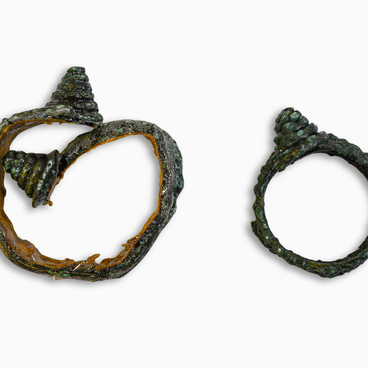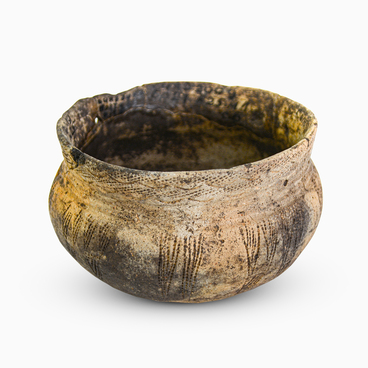The museum’s collection features a plate knife with a concave spine and a curved blade. The rise of its blade is smooth. The knife is made on the same plate with the handle. The blade is separated from the handle by a heel, which also served as a crosspiece, preventing the hand from slipping onto the blade. A triangular hole is seen on the back of the handle. This knife was created in the period from the 2nd millennium BCE to the 4th century CE, nevertheless, the preservation of the knife is satisfactory. The surface is covered with patina (oxide-carbonate film) and cavities. Parallel grooves are present on the back of the handle.
The blade of the knife has the tip turned up. A knife with such a profile has an increased length of the cutting edge line due to bending. It is convenient to carry out skinning work with such a tool. This purpose of the knife is evidenced by the rounded tip and the absence of stiffeners.
In addition, the distance of the tip from the longitudinal axis of the blade makes it problematic to use such a knife for a stab, and, therefore, its use as a weapon is unlikely. At the same time, this design also implies the weakness of the blade, which easily bent and broke. Probably, the shape of the blade was determined by the material from which it was made, since bronze is a rather fragile metal. Such knives are most efficiently used in economic activities related to the removal and processing of skins, cleaning and butchering of fish.
Such a knife indicates a developed hunting and fishing industry with a pronounced specialization of tools, sophisticated technologies for cutting prey, as well as a variety of dishes.
Despite the fact that the specific location of the
exhibit’s discovery is unknown, such objects are quite common on the
archaeological sites of the Sargat cultural and historical community in Western
Siberia and belong to the early stages of its existence (7th–5th centuries
BCE). The peoples of this region were familiar with bronze for a long time,
they made high-quality and convenient products from it while the technology of
processing iron was just emerging, and tools made of it were not yet able to
replace bronze in all spheres of the economy.

